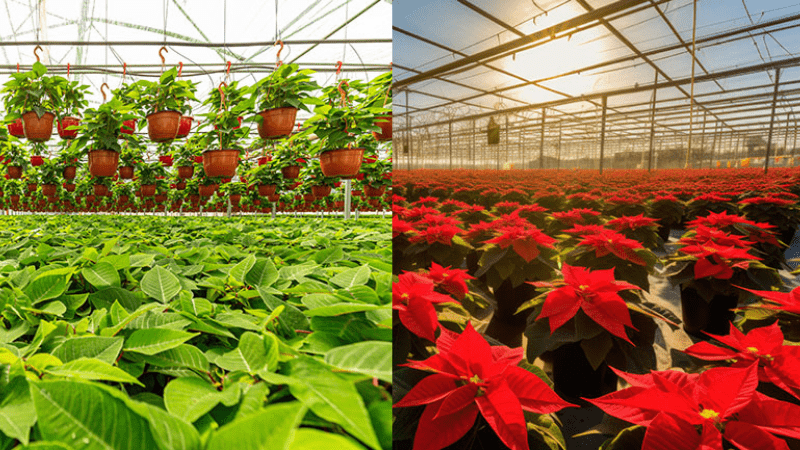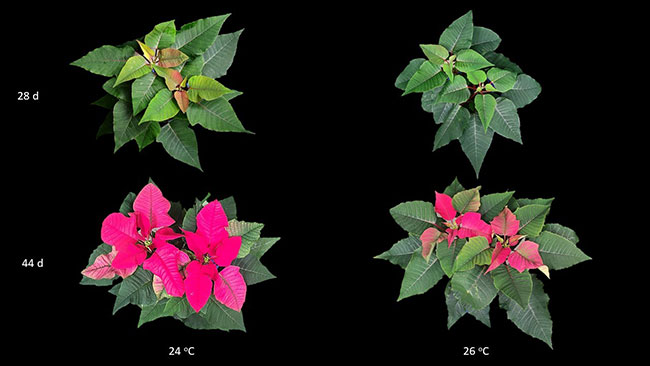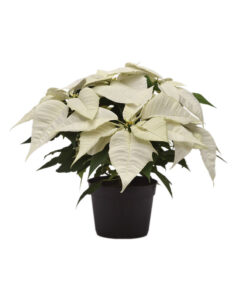
Understanding poinsettia heat delay
Delayed flowering of poinsettias due to high fall temperatures can cause growers to miss critical market dates. In this article, we present the results of a five-year study to understand the many factors that interact to cause poinsettias to flower a week or more later than expected.
WHAT IS HEAT DELAY?
Heat delay is a phenomenon known in the floricultural industry for the last 40 years that occurs when a delay in flower development happens in poinsettias exposed to high temperatures. This phenomenon actually occurs on other species, but poinsettia is most well known because a one- to two-week delay has serious market implications for a crop that is only sold for a four-week period each year.
Flower development of poinsettia is evaluated in two ways: bract color and cyathia reaching anthesis or pollen shed. Bracts are the most critical market characteristic of poinsettia flowers, but both bract and cyathia formation are delayed by high temperatures.
Temperatures that result in delayed flowering depend on several interactive factors, such as stage of floral development, photoperiod, time of day/night, and cultivar sensitivity. The following sections highlight the factors that result in delayed bract and cyathia formation.
Stage of flower development
Poinsettias are most sensitive to high temperatures when they are initiating flowers under natural day-length conditions. The initial stages of flowering, termed flower initiation, are more sensitive to high temperatures than later stages of flower development. The time of flower initiation that occurs under natural day lengths will range from early September through early October, depending on the cultivar.
The flower initiation process takes approximately two weeks. In general, early- season cultivars initiate flowers during the first two weeks in September, mid-season cultivars initiate flowers during the second and third week of September and late-season cultivars initiate in the last week of September and the
first week of October.
Since cultivars differ in the time of flower initiation under natural day lengths, a week of high temperatures during the second week of September will cause a delay on early- and mid-season cultivars while late-season cultivars will not be affected. Similarly, high temperatures towards the end of September may only affect mid- and late-season cultivars, while early-season cultivars will have already completed flower initiation and thus are no longer sensitive. This is one of the main reasons that growers observe inconsistency in which cultivars experience delay from year to year.

Photoperiod
Poinsettias begin to initiate flowers when the night lengths are approximately 12 hours, which naturally occurs in September across the northern hemisphere. Poinsettias are more sensitive to high temperatures when the night length is 12 hours compared to 13 or 14 hours.
Some growers will use blackout systems to initiate poinsettias. When these systems are used, a night length of 14 to 15 hours is typically provided. Thus, poinsettias initiated under natural day lengths are more susceptible to heat delay than crops grown under black curtains, and blackout systems can be strategically used to avoid heat delay.
Since temperature sensitivity is greatest during flower initiation and natural day length crops initiate flowers at approximately 12 hours, it is important to note that Sept. 7-Oct. 1 is the most critical time for heat delay across most cultivars.
Time of the day/night
What time of the 24-hour cycle are poinsettias most sensitive to high temperatures? Should I be concerned about day temperature, night temperature or the average daily temperature? This topic has caused much confusion over many years due to the contradictory results observed by different researchers.
Previous research has reported that night temperatures should be <73º F, while others have concluded that average daily temperatures should be <81º F.
Our research has aimed to clarify this situation. We have found that the most sensitive time of the 24-hour day is the last half of the night and the first two hours of the morning. High temperatures during the day and the early hours of the night do not appear to contribute to delayed flowering. The exact temperatures during these hours that cause heat delay vary with cultivar sensitivity, which is discussed in the next section.
Fortunately, the time of heightened sensitivity is also the coolest time of the 24 hour cycle, so growers need to continue operating the greenhouse cooling system throughout the night and morning hours in order to minimize the threat of high temperature.
As a side note, we have observed that leaf distortion starts to occur on sensitive cultivars at day temperatures of 90º F. Cultivars that are sensitive to leaf distortion are not necessarily the same cultivars that are sensitive to heat delay.
'Brilliant White'
'Christmas Eve Red'
Cultivar sensitivity
All cultivars will experience heat delay at some temperature; however, there is a broad range of sensitivity across cultivars. While all cultivars are sensitive during flower initiation, high-sensitivity cultivars are sensitive over a broader length of time. For example, high temperatures throughout October and into early November will delay flowering of Prestige, while a low- sensitivity cultivar, like Advent, will only be sensitive during flower initiation.
For low-sensitivity cultivars, 75º F is generally safe, while 79º F will delay flowering. For high-sensitivity cultivars temperatures greater than 68º F will delay flowering, but there is a progression, i.e., the amount of delay increases as temperature increases above the aforementioned temperatures until one reaches 84º F, which is the temperature that all cultivars are completely vegetative.
These temperatures are referring to the temperature during the latter half of the night and first two hours of the day.
Currently, poinsettia breeders screen new cultivars for heat sensitivity, so we don’t expect that a high-sensitivity cultivar, like Prestige, will ever be introduced in the future.
ANTICIPATING HEAT DELAY
First color development in the bracts is a useful indicator of heat delay, i.e., if the first color is delayed, the full bract color date will be delayed. Thus, growers should keep a record of the timing of first color for the various cultivars that they grow and use these dates as targets. The Ecke Bract Meter, which can be found with a Google search, provides guidelines for managing temperatures from first color to target the anticipated market date.
Acknowledgement: The authors thank the USDA-ARS-Floriculture and Nursery Research Initiative for their financial support of this project.




 Video Library
Video Library 




















